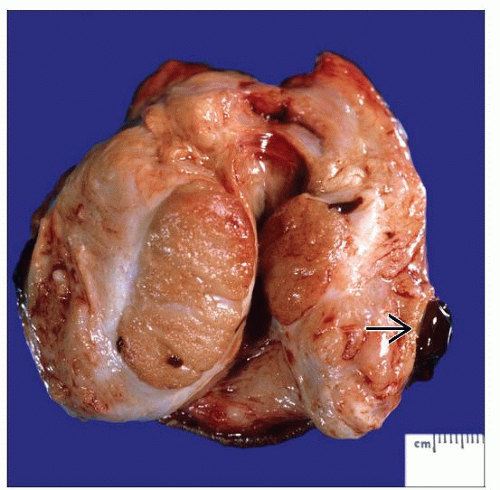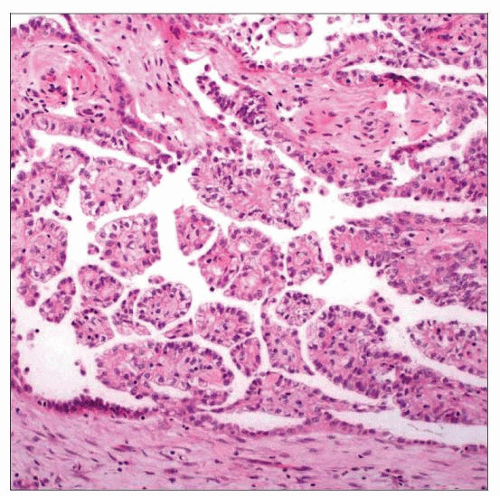Malignant Mesothelioma
Steven S. Shen, MD, PhD
Mahul B. Amin, MD
Jae Y. Ro, MD, PhD
Key Facts
Terminology
Malignant tumor originating from mesothelial cells of tunica vaginalis
Clinical Issues
Rare, but 2nd most common paratesticular malignancies after soft tissue sarcoma
< 50% reported cases associated with asbestos exposure
Age range: 6-90 years old (average: 54 years)
Paratesticular mass or associated with hydrocele; may be incidental finding during hernia repair
Microscopic Pathology
Majority are pure epithelial type (60-70%) or biphasic (30-40%)
Rare sarcomatoid or desmoplastic type occur as well
Papillary, tubulopapillary, glandular (well differentiated) or solid growth patterns (poorly differentiated)
Round or cuboidal cells with mild or moderate cellular pleomorphism and often prominent nucleoli
Dense hyperchromatic chromatin and frequent mitoses
Foam cells, psammoma bodies may be seen
Invasion is key diagnostic criterion
Ancillary Tests
Positive for PAN-CK(AE1/AE3), EMA/MUC1, vimentin, calretinin, Podoplanin(D2-40), CK5/6, thrombomodulin, mesothelin, and WT1
Negative for CEA, TAG72, CD15, EpCAM/BER-EP4/CD326
TERMINOLOGY
Synonyms
Mesothelioma
Definitions
Malignant tumor arising from mesothelial cells in tunica vaginalis
ETIOLOGY/PATHOGENESIS
Pathogenesis
Asbestos exposure is only known risk factor (associated with < 50% of cases in testicular mesothelioma)
CLINICAL ISSUES
Epidemiology
Incidence
Rare, but 2nd most common paratesticular malignancy after soft tissue sarcoma
Age
Range: 6-90 years old (average: 54 years)
10% of cases occur in patients younger than 25 years old
Presentation
Paratesticular mass or associated with hydrocele
May be incidental finding during hernia repair
Treatment
Surgical approaches
Surgical resection is choice of therapy
Adjuvant chemotherapy has been proved to have limited effect
Prognosis
Variable depending on clinical stage
MACROSCOPIC FEATURES
General Features
Variable, often diffuse thickening of tunica vaginalis with multiple friable nodules or excrescences
Tumor may invade tunica albuginea, testis, epididymis, and spermatic cord
MICROSCOPIC PATHOLOGY
Histologic Features
Majority are pure epithelial type (60-70%) or biphasic (30-40%)
Rare sarcomatoid or desmoplastic types may also occur
Papillary, tubulopapillary, glandular (well differentiated), or solid growth patterns (poorly differentiated)
Round or cuboidal cells with mild or moderate cellular pleomorphism and often prominent nucleoli
Dense chromatin with variable mitotic activity
Foam cells or psammoma bodies may be present
Cytologic atypia or mesothelial proliferation alone may not be diagnostic for malignant mesothelioma
Stay updated, free articles. Join our Telegram channel

Full access? Get Clinical Tree





